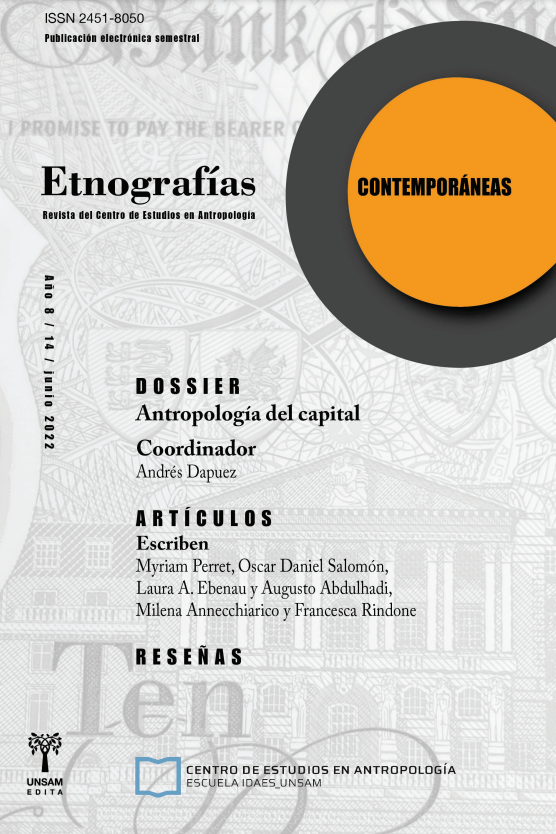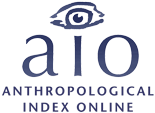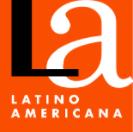The dollar as capital(s)
Demonstrations and forms of class construction in the second government of Cristina Fernández de Kirchner (2011-2015)
Keywords:
dollar, racism, capital, demonstrationsAbstract
During the entire second term of Cristina Fernández de Kirchner (2011-2015) large demonstrations against the prohibition of the purchase of dollars for saving took place. Demonstrations expressed the discontent of specific sectors that saw their way of life at risk. The US Dollar condensed a series of demands: lack of freedom (to buy foreign currency, to travel), lack of security, lack of rights, interference of the State in private life, the choice to keep the “lazy”, and the “blacks” over the workers. In this article, based on fieldwork carried out between 2012 and 2015 with groups of people who protested against the government of Cristina Fernández de Kirchner and considered themselves middle class, I analyze how the mobilization of money allowed to generate forms of differentiation between social groups. My argument is that during the protests against the government of Cristina Fernández de Kirchner, the dollar was used by a group of middle sectors as an object of social differentiation based on the ability to mobilize the North American currency between different spheres of value.
References
Adamovsky, Ezequiel (2009). Historia de la clase media argentina: Apogeo y decadencia de una ilusión, 1919-2003. Buenos Aires, Planeta.
Álvarez Leguizamón, Sonia (2017). Formas de racismo indio en la argentina y configuraciones sociales de poder. Rosario, Prohistoria.
Basualdo, Eduardo (ed.) (2017). Endeudar y fugar. Un análisis de la histórica económica argentina, de Martínez de Hoz a Macri. Buenos Aires, Siglo Veintiuno Editores.
Becker, Howard (2010). Outsiders. Hacia Una Sociología de La Desviación. Buenos Aires, Siglo Veintiuno Editores.
Benza, Gabriela (2016). “La Estructura de clases argentina durante la década 2003-2013”, en Kessler, Gabriel (ed.): La Sociedad Argentina Hoy: Radiografía de Una Nueva Estructura. Buenos Aires, Siglo Veintiuno Editores: Fundación OSDE, pp. 111-40.
Carrier, James G., y Don Kalb (eds.) (2015). Anthropologies of Class. Cambridge, Cambridge University Press.
Chakrabarty, Dipesh (2000). Provincializing Europe: Postcolonial Thought and Historical Difference. Princeton, Princeton University Press.
Dapuez, Andrés (2021). “Dinero-capital de la Asignación Universal por Hijo para la Protección Social en un barrio marginal de la ciudad de Paraná, Argentina”, Revista Colombiana de Antropología, Vol. 57, Nº 1, pp. 99-124
D’Avella, Nicholas (2019). Concrete Dreams: Practice, Value, and Built Environments in Post-Crisis Buenos Aires. Durham, Duke University Press.
De L’Estoile, Benoît (2014). “‘Money Is Good, but a Friend Is Better’: Uncertainty, Orientation to the Future, and ‘the Economy’, Current Anthropology, Vol. 55, Nº S9, pp. S62-73.
Del Cueto, Carla y Mariana Luzzi (2016). “Salir a Comprar. El Consumo y la estructura social en la Argentina reciente”, en Kessler, Gabriel (ed.): La Sociedad Argentina Hoy: Radiografía de Una Nueva Estructura. Buenos Aires, Siglo Veintiuno Editores- Fundación OSDE, pp. 209-32.
García, Alfredo (2002). “Estructura y Liquidez Del Sistema Financiero Bimonetario Argentino”, en Gambina, Julio (Ed.): La globalización económico-financiera: su impacto en América Latina. Buenos Aires, Consejo Latinoamericano de Ciencias Sociales, pp. 247-70.
Gaztañaga, Julieta (2019). “Federalismo y abertzalismo como valores de nación. Aportes antropológicos”, en Sánchez León, Pablo (ed.): Marx y la crítica de la economía política: contribuciones a una tradición. Arre, Pamiela, pp. 478-502.
Goddard, Victoria (2006). “‘This Is History’: Nation and Experience in Times of Crisis—Argentina 2001”, History and Anthropology, Vol. 17, Nº 3, pp. 267-86.
Gordillo, Gastón (2016). “The Savage Outside White Argentina”, en Paulina, Alberto; Elena, Eduardo (eds.): Rethinking Race in Modern Argentin. Cambridge, Cambridge University Press, pp. 241-67.
Graeber, David (2001). Towards an Anthropological Theory of Value: The False Coin of Our Own Dreams. New York, Palgrave.
Grimson, Alejandro (2012). Mitomanías Argentinas: cómo hablamos de nosotros mismos. Buenos Aires, Siglo Veintiuno Editores.
Guano, Emanuela (2002). “Spectacles of Modernity: Transnational Imagination and Local Hegemonies in Neoliberal Buenos Aires”, Cultural Anthropology, Vol. 17, Nº2, pp. 181-209.
Guyer, Jane (2017). “Money Is Good to Think: From ‘Wants of the Mind’ to Conversations, Stories, and Accounts,” en Hart, Keith (ed.): Money in a Human Economy. New York, Berghahn Books, pp. 43-60.
–––(2012). “Soft Currencies, Cash Economies, New Monies: Past and Present”, Proceedings of the National Academy of Sciences, Vol. 109, Nº 7, pp. 2214-21.
–––(2004). Marginal Gains.Monetary Transactions in Atlantic Africa. Chicago, University of Chicago Press.
Hart, Keith (2017). “Introduction. Money in a Human Economy” en Hart, Keith (ed.): Money in a Human Economy. New York, Berghahn Books, pp. 4-14.
Heiman, Rachel; Freeman, Carla; Liechty, Mark (Eds.) (2012) The Global Middle Classes: Theorizing through Ethnography. Santa Fe, SAR Press.
Hutchinson, Sharon (1996). Nuer Dilemmas: Coping with Money, War and the State. Berkeley, University of California Press.
Kessler, Gabriel (2014). Controversias Sobre La Desigualdad. Argentina, 2003-2013. Buenos Aires, FCE.
Kessler, Gabriel; Benza, Gabriela (2020), “Nuevas Clases Medias: Acercar La Lupa” en: Nueva Sociedad https://nuso.org/articulo/nuevas-clases-medias-acercar-la-lupa/ (accedido el 14 de enero de 2021).
Knight, Daniel M (2012). “Cultural Proximity: Crisis, Time and Social Memory in Central Greece”, History and Anthropology, Vol. 23, Nº 3, pp. 349-74.
Lander, Edgardo (ed.) (2000). La Colonialidad Del Saber: Eurocentrismo y Ciencias Sociales: Perspectivas Latinoamericanas. Buenos Aires, CLACSO ; UNESCO.
Latour, Bruno (2008). Reensamblar lo social: Una introducción a la teoría del actor-red. Buenos Aires, Manantial.
Levi-Strauss, Claude (1965). El Totemismo En La Actualidad. México, FCE.
Lomnitz, Claudio (2003). “Times of Crisis: Historicity, Sacrifice, and the Spectacle of Debacle in Mexico City”, Public Culture, Vol. 15, Nº 1, pp. 127-47.
Luzzi, Mariana (2016). “Quelle Est La Monnaie de l’épargne? Controverses Érudites et Profanes à Propos de La Valeur Des Dépôts Bancaires en Argentine”, La vie des idèes.fr: 1-15.
Luzzi, Mariana; Wilkis, Ariel (2019). El Dólar. Historia de Una Moneda Argentina (1930-2019). Buenos Aires, Crítica.
Luzzi, Mariana; Wilkis, Ariel (2018). “Soybean, Bricks, Dollars, and the Reality of Money: Multiple Monies during Currency Exchange Restrictions in Argentina (2011-15)”, HAU: Journal of Ethnographic Theory, Vol. 8, Nº 1-2, pp. 252-64.
Narotzky, Susana (2007). “The Project in the Model. Reciprocity, Social Capital, and the Politics of Ethnographic Realism”, Current Anthropology, Vol. 48, Nº 3, pp. 403-24.
Narotzky, Susana; Besnier, Niko (2014). “Crisis, Value, and Hope: Rethinking the Economy: An Introduction to Supplement 9”, Current Anthropology, Vol. 55, Nº. S9, pp. S4-16.
Neiburg, Federico (2010). “Sick Currencies and Public Numbers”, Anthropological Theory, Vol. 10, Nº 1-2, pp. 96-102.
Neiburg, Federico (2007). “As Moedas doentes, os números públicos e a antropologia do dinheiro”, Mana, Vol. 13, Nº 1, pp. 119-51.
Neiburg, Federico (2004). “Economistas e culturas econômicas no Brasil e na Argentina. Notas para uma comparação a propósito das heterodoxias”, Tempo Social, Vol. 16, Nº 2, pp. 177-202.
Nelms, Taylor; Maurer, Bill (2014). “Materiality, Symbol, and Complexity in the Anthropology of Money”, en Bijleveld, Erik; Aarts, Henk (Eds.): The Psychological Science of Money. New York, Springer New York, pp. 37-70.
O’Dougherty, Maureen (2002). Consumption Intensified: The Politics of Middle-Class Daily Life in Brazil. Durham, Duke Univ. Press.
Oliven, Ruben George. 2014. “Clase Media, Consumo y Ciudadania”, en Adamovsky, Ezequiel; Visacovsky, Sergio y Vargas, Patricia (Eds.): Clases medias: nuevos enfoques desde la sociología, la historia y la antropología. Buenos Aires, Ariel, pp. 201-12.
Perelman, Mariano (2021) “Dollars, pesos, and planes. Reconstruction of class borders in the second government of Cristina Fernández de Kirchner (2011–2015)”, Dialectical Anthropology, Vol 45, No 1, pp. 253-273.
–––(2017) “Notes about Racist Argentina and a Class-based Government”, American Anthropologist, Vol. 119, Nº 3, pp. 532-534
–––(2004): “¿Ahorristas Unidos?, Jamás serán vencidos”, en Lobeto, Claudio (ed:) Prácticas socioestéticas y representaciones en la Argentina de la crisis. Buenos Aires: Grupo de Estudios Sociales del Arte y la Cultura, pp. 167-183.
Pita, María Victoria (2017a). “Pensar la Violencia Institucional”, Revista Espacios de Crítica y Producción, Vol. 53, pp. 33-42.
–––(2017b). “Violencias y trabajos clasificatorios. Wl análisis de la noción ‘violencia institucional’ qua categoría política local”, Ensambles, Vol. 4, Nº 7, pp. 52-70.
–––(2010). Formas de morir y formas de vivir. El activismo contra la violencia policial. Buenos Aires, Editores del Puerto y CELS.
Pollak, Michael (1992). “Memória e Identidade Social”, Estudos Históricos, Vol. 5, Nº 10, pp. 200-212.
Sánchez, María Soledad (2017). “El Dólar Blue como ‘número público’ en la Argentina posconvertibilidad (2011-2015)”, Revista mexicana de sociología, Vol. 79, Nº 1, pp. 7-34.
–––(2016). “Economía y moral en blue. Un estudio sociológico sobre el mercado ilegal del dólar en la Argentina de la posconvertibilidad.” PhD. Tesis in Social Science. Universidad de Buenos Aires.
Visacovsky, Sergio (2021). “Las crisis sociales: problemas en torno a la experiencia y narración de la temporalidad y la imaginación del futuro”, en Di Virgilio, María Mercedes; Perelman, Mariano (Eds.): Desigualdades urbanas en tiempos de crisis. Santa Fe, Universidad Nacional del Litoral y FLACSO Argentina, pp. 33-54.
–––(2012). “Experiencias de descenso social, percepción de fronteras sociales e identidad de clase media en la Argentina post-crisis”, Pensamiento Iberoamericano, Vol. 10, pp. 133-68.
Visacovsky, Sergio; Garguin, Enrique (eds) (2009). Moralidades, economías e identidades de clase media: estudios históricos y etnográficos. Buenos Aires, EA.
Wilkis, Ariel (2018). The Moral Power of Money: Morality and Economy in the Life of the Poor. Stanford, Stanford University Press.
--(2013). Las sospechas del dinero. Moral y economía en la vida popular. Buenos Aires, Paidós.
Zenobi, Diego (2007). “De la pasión por el ‘dinero’ a la defensa del ‘ahorro’. Transformances, arena pública e identidades”, E-misférica 4(1): 1-19.
























